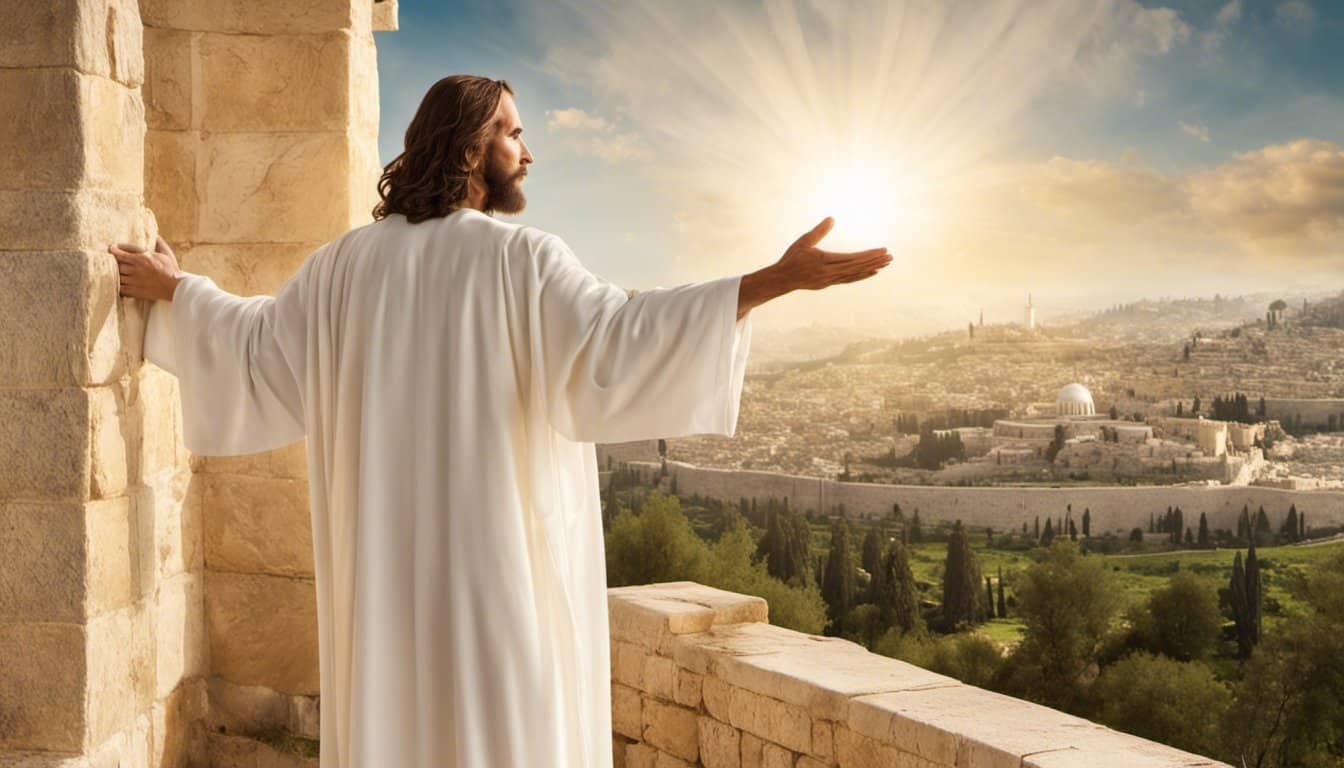The Transfiguration stands as one of the most awe-inspiring moments in the life of Christ, offering a glimpse into His divine nature. On a quiet mountaintop, Jesus revealed a radiant glory that left His closest disciples in wonder. This extraordinary event wasn’t just about dazzling light; it was a profound moment of spiritual revelation.
For those who witnessed it, the Transfiguration confirmed that Jesus was more than a teacher or prophet—He was the Son of God. It’s a moment that invites believers to reflect on His true identity and the eternal hope He brings. Through this event, the veil between heaven and earth seemed to lift, offering a brief but powerful vision of God’s kingdom.
Exploring the Transfiguration Glory

The Transfiguration Glory offers a profound insight into Christ’s divine nature. This event, detailed in the Gospels of Matthew 17:1-8, Mark 9:2-8, and Luke 9:28-36, reveals Jesus as fully God and fully man. His radiant appearance on the mountaintop wasn’t just a moment of spiritual awe; it provided clarity on His mission and identity for the disciples.
The Setting of the Transfiguration
The Transfiguration occurred on a high mountain, traditionally associated with Mount Tabor or Mount Hermon. Jesus selected Peter, James, and John, three of His closest disciples, to witness this event. The choice of an elevated spot symbolized a closer encounter with God, as mountains often represented places of divine revelation in scripture (e.g., Moses on Mount Sinai). This setting reinforced the separation required to witness Christ’s glory firsthand.
Jesus’s Radiance Explained

During the Transfiguration, Jesus’s face shone like the sun, and His clothes became dazzling white (Matthew 17:2). This transformation signified the unveiling of His divine nature. The brightness wasn’t a reflection of external light but an emanation of His inherent glory as God. This was a direct affirmation of John 1:14, where the Word is described as “full of grace and truth.”
The Presence of Moses and Elijah
Moses and Elijah appeared alongside Christ during this moment. Their presence symbolized the fulfillment of the Law and the Prophets, pointing to Jesus as the culmination of God’s redemptive plan. Moses represented the Law, having received it from God, while Elijah embodied the prophetic tradition. Together, they illustrated the unity of scripture fulfilled through Jesus.
Peter’s Reaction and Its Implications
Peter, overwhelmed by the scene, proposed building three shelters—one for Jesus, Moses, and Elijah. His response, recorded in Mark 9:5-6, reflected a mixture of reverence and misunderstanding. While Peter recognized the significance of the event, he failed to fully grasp that Jesus alone was the central figure. God’s declaration moments later, “This is my Son, whom I love. Listen to Him!” (Mark 9:7), corrected Peter’s focus, emphasizing Christ’s singular authority.
A Glimpse of Heaven’s Kingdom
The Transfiguration wasn’t just a historical event; it illustrated the coming of God’s kingdom, as seen in Luke 9:27. It gave the disciples—and by extension, all believers—a foretaste of the promise of eternal life. The glorified Christ demonstrated the hope of resurrection and transformation for those who follow Him.
Practical Reflection
Believers are reminded to listen to Jesus, just as God commanded on the mountain. Regular study of His teachings in scripture, alongside prayer, ensures that His truth becomes their guide. They’re also called to recognize moments of God’s glory in the everyday, reflecting the radiance of Christ in their own lives through actions, words, and relationships.
Biblical Accounts of the Transfiguration
The Transfiguration event, recorded in three Gospels, provides a profound revelation of Christ’s divine identity. Each Gospel account offers unique nuances, enriching the understanding of this extraordinary moment.
The Gospel of Matthew
Matthew 17:1–8 captures the Transfiguration with vivid detail. Six days after Jesus predicted His death, He took Peter, James, and John to a high mountain. There, His appearance changed dramatically—His face shone like the sun, and His clothes became white as light. Moses and Elijah appeared, representing the Law and the Prophets.
Peter, overwhelmed, suggested building three shelters to honor Jesus, Moses, and Elijah. But a bright cloud overshadowed them, and God’s voice declared, “This is my Son, whom I love; with Him, I am well pleased. Listen to Him!” The disciples fell face down in fear until Jesus reassured and encouraged them. This account highlights Christ’s divine authority and fulfills Old Testament prophecies.
The Gospel of Mark
Mark 9:2–8 recounts the same event but places emphasis on awe and fear. Mark specifies that Jesus led the disciples “alone by themselves” to the mountaintop, underlining the intimacy of the moment. Jesus’ clothes became dazzling, whiter than any earthly bleach could make them, signifying His heavenly glory.
Once again, Peter reacted impulsively, offering to set up tents. However, the voice from the cloud redirected their focus to Jesus, affirming His identity as the beloved Son of God. This Gospel stresses the disciples’ struggle to grasp the full meaning of what they saw, reflecting their human limitations.
The Gospel of Luke

Luke 9:28–36 introduces a unique detail: Jesus went up the mountain to pray. As He prayed, His face changed, and His clothes became bright like a flash of lightning. Moses and Elijah spoke with Him about His coming departure, referencing His crucifixion and resurrection in Jerusalem.
The disciples, initially sleepy, fully awoke to witness Jesus’ glory and the heavenly visitors. When Peter suggested building shelters, the cloud enveloped them, leading to fear. God’s voice, declaring Jesus as His chosen Son, echoes the command to “Listen to Him!” Luke underscores the connection between prayer, divine revelation, and Christ’s mission.
These Gospel accounts collectively enrich the understanding of the Transfiguration. Each adds unique perspectives, emphasizing aspects like glory, prophecy, prayer, and the disciples’ responses. Together, they invite believers to reflect on Christ’s divine nature and His fulfillment of God’s redemptive plan.
Theological Significance of Christ’s Transfiguration
The Transfiguration is a profound event that reveals key truths about Jesus’ identity and God’s redemptive plan. By reflecting on this moment, believers deepen their understanding of Christ’s glory and purpose.
Revealing Christ’s Divine Nature
During the Transfiguration, Christ’s divine nature shone through His human form. According to Matthew 17:2, His face “shone like the sun,” and His clothes became dazzling white—presenting a clear glimpse of His glory. This wasn’t a change in His essence but a momentary unveiling of the divine radiance He always possessed.
The disciples were overwhelmed by this revelation of Jesus’ true nature, proving He wasn’t just a prophet or teacher. His transformation confirmed His deity, aligning with John 1:14, which states, “We have seen His glory, the glory of the One and Only Son.” This event encouraged them to trust and believe in His mission, demonstrating He was fully God in human flesh.
Affirming Jesus as the Son of God
God’s audible declaration at the Transfiguration affirmed Jesus as His beloved Son. Matthew 17:5 records the voice from the cloud saying, “This is My beloved Son, with whom I am well pleased; listen to Him!” This divine affirmation emphasized Christ’s unique relationship with the Father and His unparalleled authority.
For the disciples, this was a call to obedience and faith. God’s command to “listen” elevated Jesus above all earthly authorities, including Moses and Elijah, who were present. It showed that Jesus was not a continuation but the fulfillment of God’s plan. The affirmation strengthened their understanding and prepared them for the challenges they would face as His followers.
Connection to Old Testament Prophecies
The presence of Moses and Elijah symbolized the fulfillment of the Law and the Prophets, connecting the event to Old Testament prophecies. Moses represented the Law given to Israel, while Elijah embodied the prophetic voice that pointed toward the Messiah. Their appearance confirmed that Jesus completed what they foretold.
Scriptures like Deuteronomy 18:15, which speaks of a prophet like Moses, and Malachi 4:5, which foretells Elijah’s return, align with the Transfiguration. This moment wasn’t just about Jesus’ glory but also about verifying that He was the prophesied Messiah. The disciples, steeped in Jewish tradition, would’ve recognized the significance of these connections.

Through this event, believers today see that Christ fulfills God’s promises and His work spans both covenants. It bridges the continuity of Scripture, encouraging reflection on Jesus’ role in God’s grand narrative.
Lessons From the Transfiguration for Believers
The Transfiguration offers profound lessons for believers, revealing Christ’s glory and purpose while guiding them in their spiritual journey. These lessons deepen understanding of Christ’s divine authority, strengthen faith, and highlight the importance of obedience.
Understanding Christ’s Authority
The Transfiguration underscores Jesus’ authority as God’s Son. In Matthew 17:5, God declares, “This is my beloved Son, with whom I am well pleased; listen to him.” This statement affirms His supremacy over all spiritual and earthly leaders, underscoring His unique role in God’s plan.
Through the appearance of Moses and Elijah, representing the Law and the Prophets, believers see that Christ fulfills all Scripture. Practical application includes prioritizing His teachings above traditions or personal opinions. For example, when facing moral dilemmas, aligning decisions with Christ’s words guarantees a sound foundation rooted in God’s will.
Strengthening Faith Through Revelation
The radiant transformation of Christ revealed His divine essence, strengthening the faith of Peter, James, and John. It reminded them—and continues to remind believers—that God’s promises endure despite challenges. Mark 9:6 illustrates the disciples’ awe, noting they were terrified yet captivated by the event.

Believers today can experience similar faith-strengthening moments by immersing themselves in Scripture and seeking God through prayer. When they open their hearts to God, revelations come, whether through answered prayers, a deeper understanding of His Word, or moments of peace during hardships.
The Call to Listen and Follow
God commanded, “Listen to him,” directly instructing the disciples to heed Jesus’ guidance. This call challenges believers to actively listen, not just with their ears, but with their actions. Obedience involves applying His teachings in everyday life, such as extending forgiveness or showing compassion, as emphasized in Matthew 5:7.
Practical steps include setting time for regular reflection on Jesus’ words, attending Bible studies, and praying for discernment. For example, Acts 2:42 inspires community involvement by describing early Christians’ dedication to fellowship and the apostles’ teaching. Following Christ isn’t about perfection but consistent, wholehearted effort.
Reflections on Seeing Christ’s True Nature Today
Seeing Christ for who He truly is remains a central part of Christian faith. While believers aren’t physically present to witness His Transfiguration like Peter, James, and John, there’s still a call to seek His glory in everyday life. Scripture, prayer, and fellowship provide key ways to reflect on and connect with Christ’s nature today.
1. Learning Through Scripture
The Bible continues to reveal Christ’s divine nature through His teachings and actions. Adam emphasizes the importance of consistent Bible reading, pointing out verses like John 1:14, which remind readers that “the Word became flesh” and showed God’s glory.

He suggests starting with the Gospels—Matthew, Mark, Luke, and John—since they offer the clearest picture of Jesus. For those new to this, Adam recommends focusing on one Gospel at a time, taking notes about what Jesus says and does.
2. Seeking Christ in Prayer
Prayer provides believers the chance to enter into God’s presence and experience spiritual transformation. Adam views prayer as not just talking to God but also listening for His guidance. He advises setting aside time daily, even if it’s five quiet minutes to reflect, confess, and listen.
Prayers shared corporately—like in church groups—also create opportunities to strengthen faith by hearing others’ experiences of seeing Christ’s nature revealed in their lives.
3. Building Community Through Fellowship
Gathering with others brings Christ’s transformative power into daily interactions. Adam frequently mentions Hebrews 10:24-25, where believers are urged to not forsake meeting together. He encourages involvement in church small groups or finding prayer partners.
Fellowship challenges and inspires Christians to adopt Christ’s character. For example, acts of service or discussions around Scripture often foster spiritual growth and deeper understanding of God’s love.
4. Recognizing Moments of Glory

Christ’s beauty is often seen through the seemingly small victories or miracles in life. Adam encourages Christians to look for these moments, reminding them that God’s presence isn’t limited to major events. Whether it’s answered prayer or peace during trials, God’s glory is evident when believers pay attention.
A practical step he highlights involves journaling gratitude daily. Writing down instances of God’s provision or blessings serves as a real-time record of His ongoing presence.
5. Obeying the Call to Follow Christ
Reflecting on His true nature comes with an invitation to action. Adam draws from Matthew 17:5, where the voice of God commands, “Listen to Him.” He sees this as a challenge to live out Christ’s teachings—not just understand them.
He advises starting small by practicing forgiveness, showing kindness, or maintaining honesty in tough situations. These acts mirror Christ’s nature and let His glory shine through believers.
Conclusion
The Transfiguration invites believers to marvel at Christ’s divine nature and embrace the hope He brings. It’s a reminder of His glory, authority, and the fulfillment of God’s redemptive plan. By seeking His presence through Scripture, prayer, and fellowship, believers can experience moments of His glory in their own lives.

This transformative encounter encourages a deeper relationship with Christ and a commitment to live out His teachings. Through acts of love and faith, believers reflect His nature and point others to the hope found in Him. The call to “listen to Him” remains as vital today as it was on that mountaintop.












